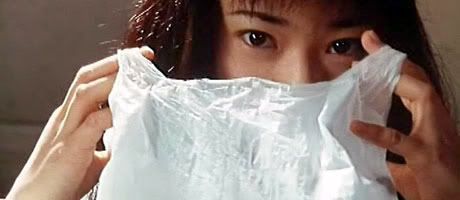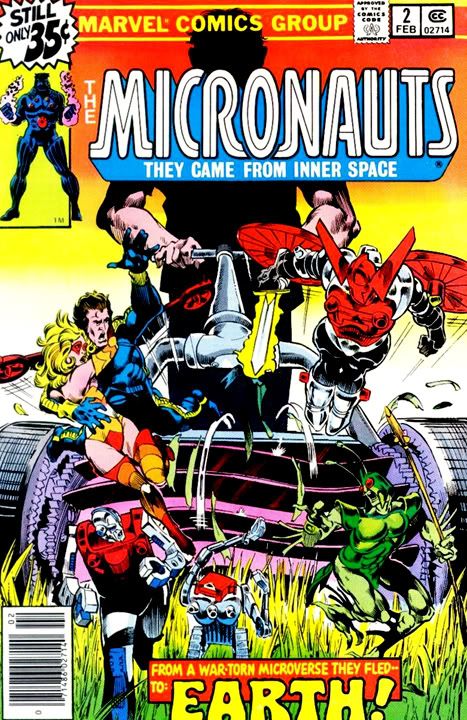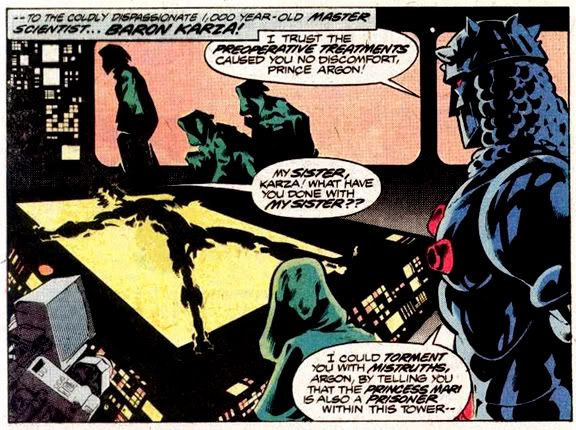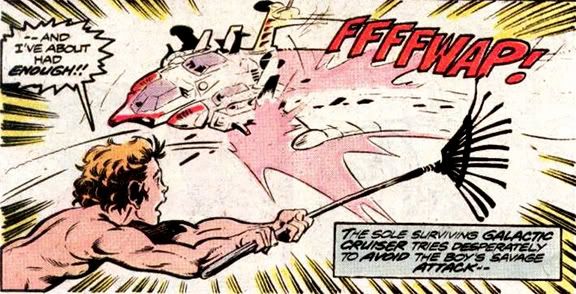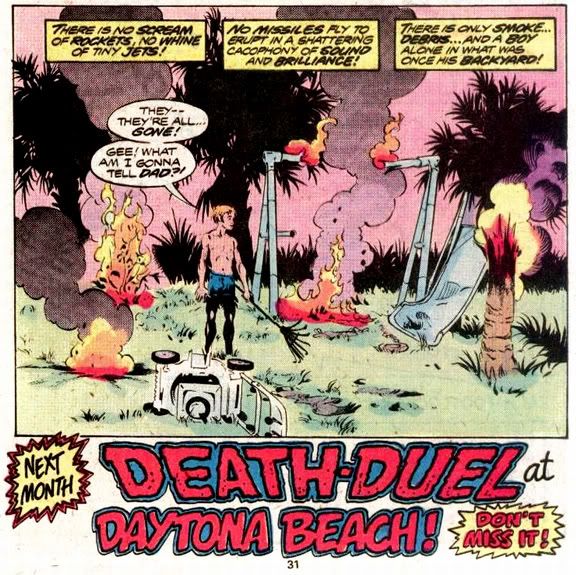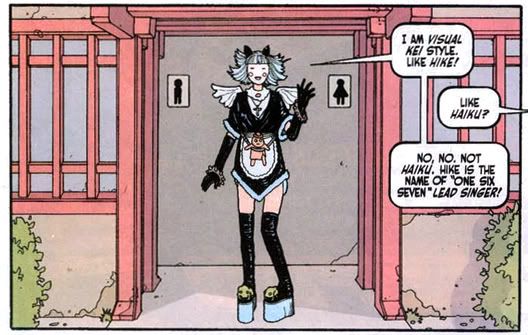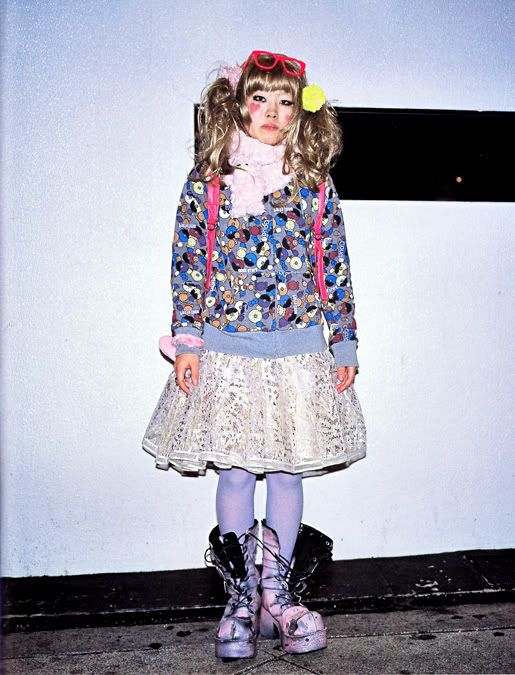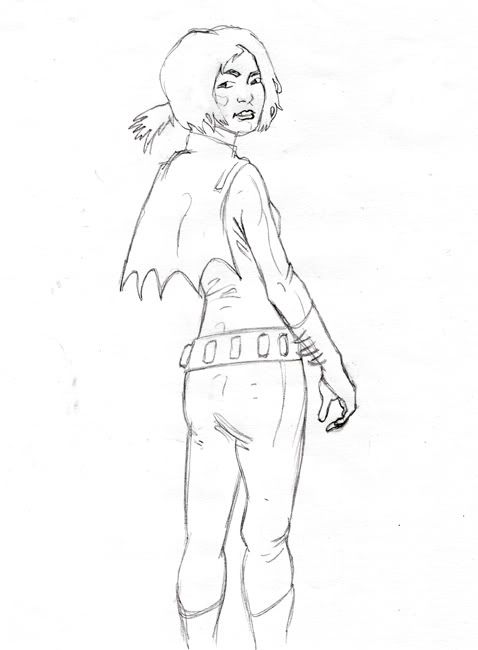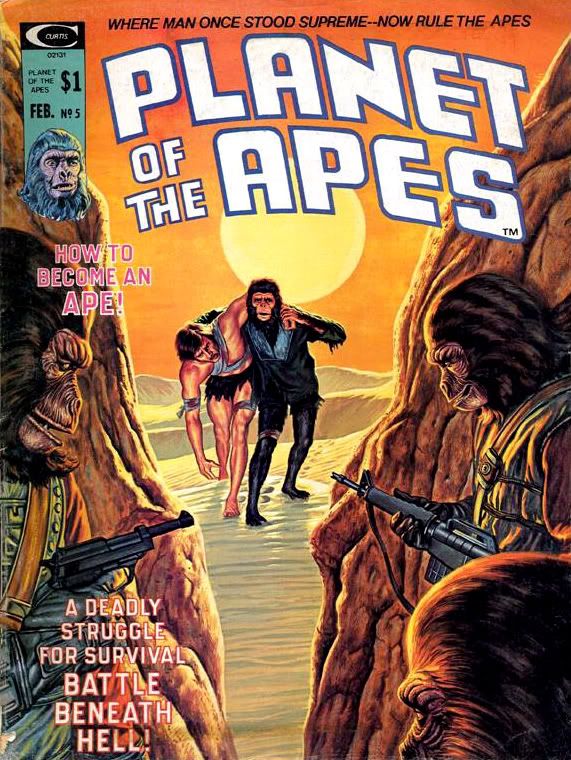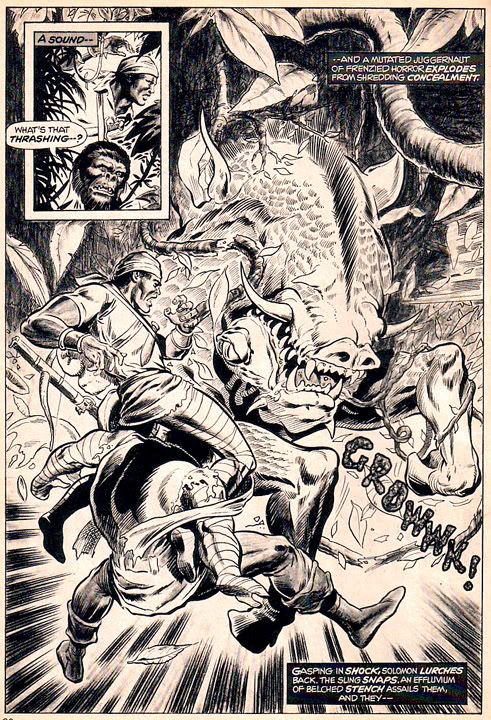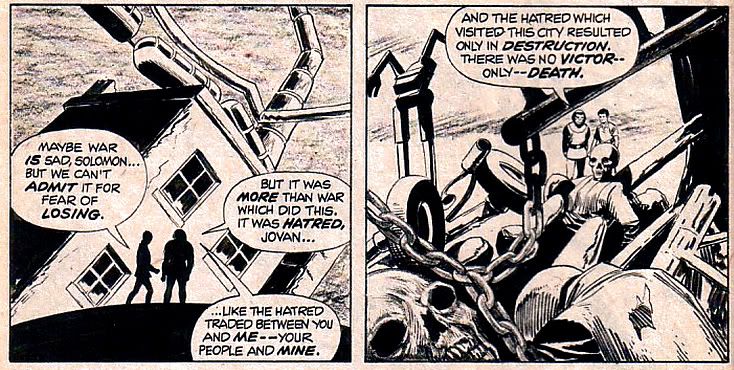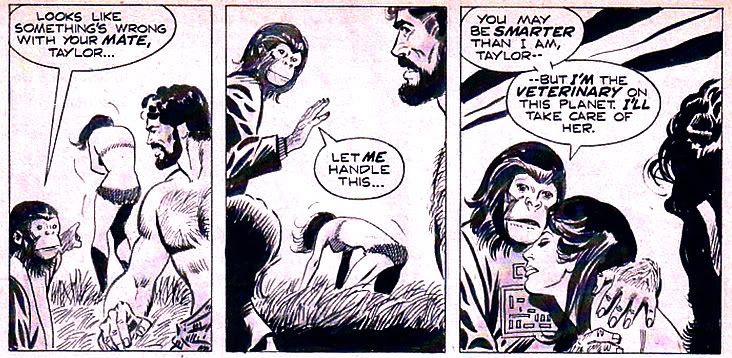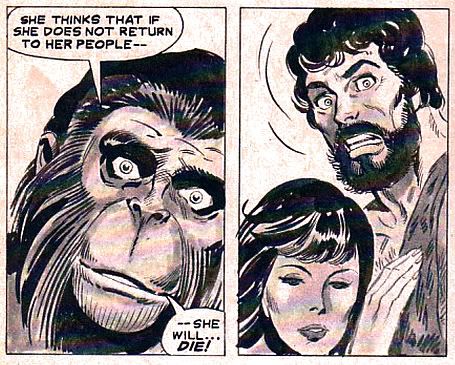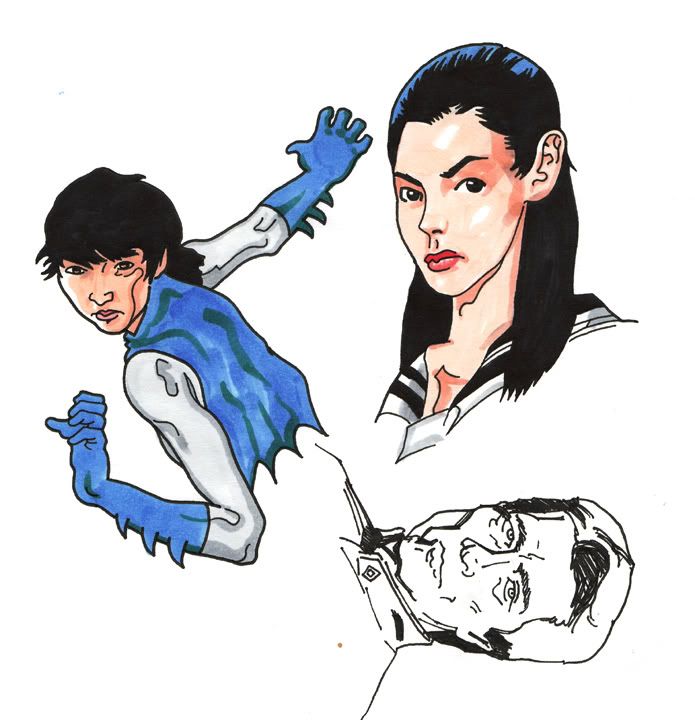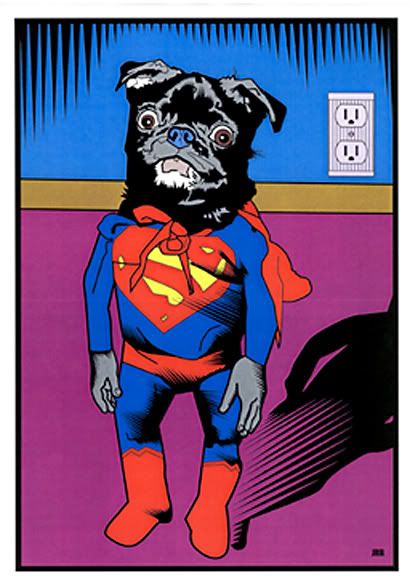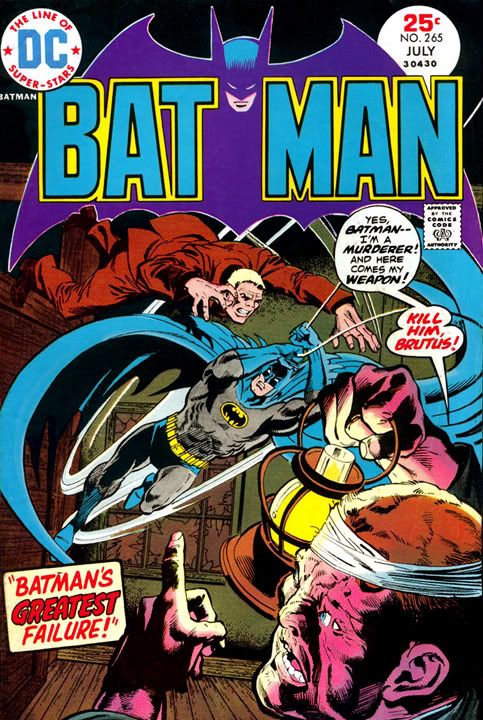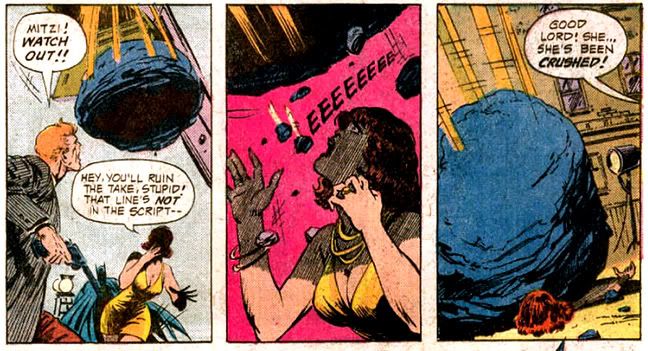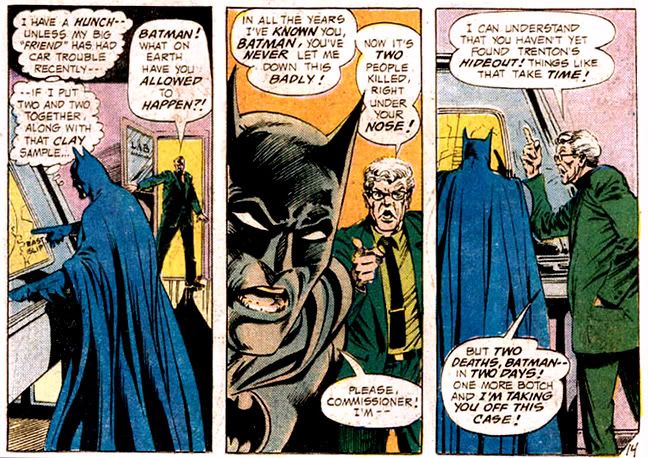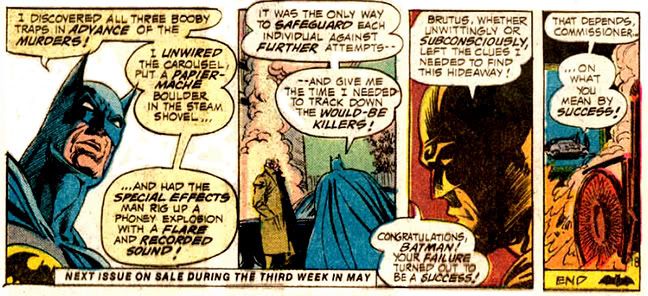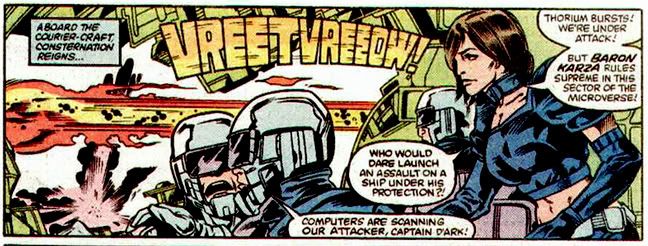 She appears to have anticipated Vera Wang's 2006 Spring/Summer collection (check out the seventh photo there especially) by about twenty years, but because she's an evil minion of crazed scientist Baron Karza, Captain D'Ark puts her own kinky spin on black with puff sleeves. Captain D'Ark. Captain D'Ark. Who the hell is Captain D'Ark? That's the whole point, kid!
She appears to have anticipated Vera Wang's 2006 Spring/Summer collection (check out the seventh photo there especially) by about twenty years, but because she's an evil minion of crazed scientist Baron Karza, Captain D'Ark puts her own kinky spin on black with puff sleeves. Captain D'Ark. Captain D'Ark. Who the hell is Captain D'Ark? That's the whole point, kid!What is my fascination with extreme characters, even nasty pieces of work like Captain D'Ark? I don't know. Similarly, Captain D'Ark's origins are a mystery. There was a Major D'Ark who perished by the sword on the Acroyear planet way back in issue #10. Perhaps this Captain was intended to be his wife, or sister or daughter or niece. Or even his resurrection, although that doesn't explain her crazy uniform with its strange mixed signals of both the butch and the femmy. Perhaps military service and loyalty to Karza runs in the D'Ark family. When her father/uncle/brother/husband gave his life for Karza, she decided she could do no less. Speculation, because we learn absolutely nothing about her back story. She remains something of an enigmatic figure, pure villainy destined for disillusionment and destruction.
She guest stars as the secondary villain in Micronauts #57. We first meet her in her role as bold commander, standing on the bridge of one of Karza's courier ships, then engaging Marionette in a savage swordfight. The bold commander with a dog collar and a puff sleeved cropped top. Captain D'Ark captured my attention with her fashion sense, where she combines such disparate elements as militarism, fascism, sexy and cute into one unique uniform. Or did all of Karza's female officers sport this look?
 I really can't get over that all-black outfit. I think it's the puff sleeves that put it over the top, even more so than the punk rock dog collar, the opera-length fingerless gloves or the thigh-high boots with cut-out detailing, or even the bare middrift. Basically, her uniform is a fairly modest bikini accessorized with a web-belt. We've actually seen something similar before, in the 1962 James Bond flick Dr. No, but in that case the bikini was white because the wearer was on the side of good. Capt. D'Ark is our enemy in wicked black, but those puff sleeves really soften her look. I dunno... despite myself, I kind of like her. In the words of Crow T. Robot, "She's just really, really neat."
I really can't get over that all-black outfit. I think it's the puff sleeves that put it over the top, even more so than the punk rock dog collar, the opera-length fingerless gloves or the thigh-high boots with cut-out detailing, or even the bare middrift. Basically, her uniform is a fairly modest bikini accessorized with a web-belt. We've actually seen something similar before, in the 1962 James Bond flick Dr. No, but in that case the bikini was white because the wearer was on the side of good. Capt. D'Ark is our enemy in wicked black, but those puff sleeves really soften her look. I dunno... despite myself, I kind of like her. In the words of Crow T. Robot, "She's just really, really neat."I can't remember if Crow said that about Beverly Garland, Kim Cattrall, Estelle Winwood or Gamera the giant turtle, but no matter.
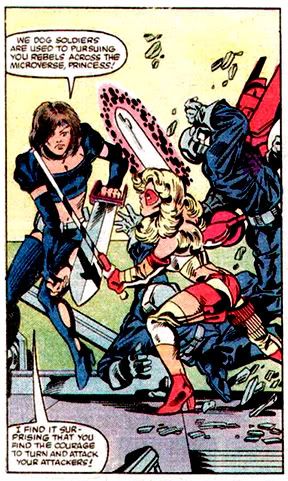 With her dramatic visual presentation, Captain D'Ark is saying, "Yes, I'm a bad-ass... but I have a soft side, too. See, I don't just love combat and discipline. I also frequently enjoy cuddling with my Hello Kitty goods... when I'm not destroying rebellion and rockin' out to Joan Jett."
With her dramatic visual presentation, Captain D'Ark is saying, "Yes, I'm a bad-ass... but I have a soft side, too. See, I don't just love combat and discipline. I also frequently enjoy cuddling with my Hello Kitty goods... when I'm not destroying rebellion and rockin' out to Joan Jett."When she and Marionette cross blades, it's not only a sword-fight, it's also a philosophical discourse. Yes, these two warriors are poles apart. One is a determined killer and the other is a killer who's determined. One wants to help her beloved Baron Karza rule the Microverse and the other wants peace and freedom and to chop off your head if you disagree.
What I really admire about both of them is the strength of their convictions. Captain D'Ark is no dupe or conscript; she's a willing volunteer, totally committed to being a dog soldier, to upholding Karza's dictatorial regime, of supporting genocide because she wants to "better bask in the greater glory of Baron Karza." She's proud of her status. Her mentality is certainly horrifying, but we have to accept that Captain D'Ark is something of a twisted idealist and a hero-worshipper. And she's capable of defending these seemingly indefensible beliefs with not only weaponry, but also her argumentative abilities. Marionette is also totally committed to murder, but only if it serves her more personal purposes.
Of course, Marionette kicks Captain's D'Ark's ass and is ready to kill her. But then Commander Rann, who has become a wimpy pacifist peacenik commie pinko loser, steps in with a disparaging comment. Add sexist to Rann's list of asinine characteristics. Micronaut? Microasshole is more like it.
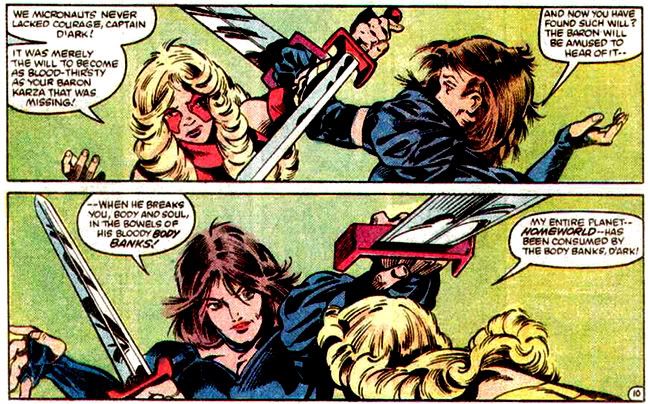 Then, the Micronauts use these glowing Tinkerbell fairies to extract information from Captain D'Ark about Karza's latest nefarious scheme, but they don't bother to secure their prisoner. As soon as the Microdumbasses turn their backs, Captain D'Ark leaps into an escape pod and rockets away. She's tenaciously evil. And that's the best kind of evil!
Then, the Micronauts use these glowing Tinkerbell fairies to extract information from Captain D'Ark about Karza's latest nefarious scheme, but they don't bother to secure their prisoner. As soon as the Microdumbasses turn their backs, Captain D'Ark leaps into an escape pod and rockets away. She's tenaciously evil. And that's the best kind of evil! Her reward for failure is she gets to hang out with her idol, Baron Karza. I don't know why Karza doesn't kill her for giving away his plan. He once slaughtered a pizza delivery boy for coming to the Body Banks three minutes late. Maybe he's mellowed after being repeatedly killed and resurrected. Whatever his reasons, Karza lets Captain D'Ark bask in his greater glory while the whole Micronauts gang sneaks up on them on some wintery planet populated by feline creatures whose culture is entirely derived from Native American tribes.
Her reward for failure is she gets to hang out with her idol, Baron Karza. I don't know why Karza doesn't kill her for giving away his plan. He once slaughtered a pizza delivery boy for coming to the Body Banks three minutes late. Maybe he's mellowed after being repeatedly killed and resurrected. Whatever his reasons, Karza lets Captain D'Ark bask in his greater glory while the whole Micronauts gang sneaks up on them on some wintery planet populated by feline creatures whose culture is entirely derived from Native American tribes.What kind of ludicrous crap has Captain D'Ark gotten herself involved in? Well, Karza is planning to burn the planet lifeless with a giant mirror, despite having a mighty spacefleet at his command that could probably accomplish the same destruction more efficiently and safely from space. But what's the point of being an evil genius if you can't come up with ridiculously complex plans that are easily foiled?
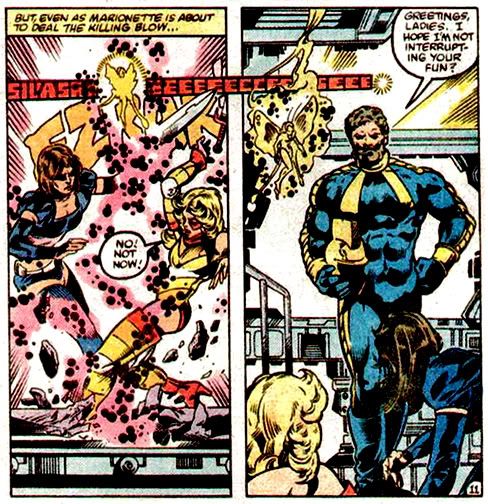 Sure enough, the Micronauts attack, and Marionette and Captain D'Ark, both now dressed slightly more sensibly against the frigid temperatures, go at it again. They've become mortal enemies in just a few short days. Their philosophies diametrically opposed, their methodologies mostly the same. They're sort of like Joseph Conrad doubles, a la "The Secret Sharer."
Sure enough, the Micronauts attack, and Marionette and Captain D'Ark, both now dressed slightly more sensibly against the frigid temperatures, go at it again. They've become mortal enemies in just a few short days. Their philosophies diametrically opposed, their methodologies mostly the same. They're sort of like Joseph Conrad doubles, a la "The Secret Sharer."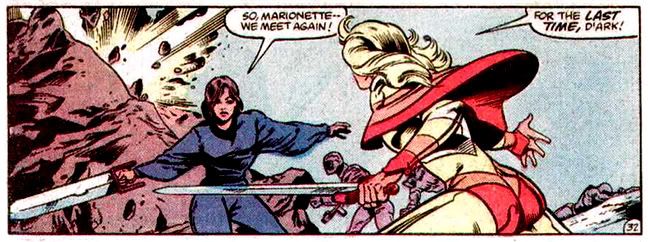 Then Karza does something that shatters Captain D'Ark's entire belief system-- he starts killing his own soldiers. Here's where Captain D'Ark's philosophy fails, where her proud speech defending her life-choices suddenly rings richly ironic. "Fuck this," Captain D'Ark thinks, then hightails it.
Then Karza does something that shatters Captain D'Ark's entire belief system-- he starts killing his own soldiers. Here's where Captain D'Ark's philosophy fails, where her proud speech defending her life-choices suddenly rings richly ironic. "Fuck this," Captain D'Ark thinks, then hightails it.Never to be seen again. We never learn where she came from, never learn much more about her motivations than that "bask in the glory" speech and her instincts for self-preservation, never discover her fate. Did she escape to safety? And after such a devastating philosophical wound, would it matter to her anymore?
She's a loathsome human being, but in a way, I kind of feel sorry for her. She hitched her wagon to the wrong star, fell completely for Karzaian propaganda. I imagine D'Ark spending many dim days ahead wondering how she could have been fooled so completely, overcome with with despair at times, perhaps even suicidal thoughts. "What a fool I was to give myself over so completely to that madman... I was ready to kill for him," she remonstrates herself, "Ready to die for him!"
Perhaps she eventually finds her way to the Prometheus Pit entrance and emerges normal human-size in the ruins of the Human Engineering Life Laboratory at the Kennedy Space Center. Eluding the military police with some of her dog soldier training, she makes her way to New York and seeks solace by drinking alone in a Manhattan bar. There she makes some helpful acquaintances, repents her militaristic past and gets involved in the fashion industry where she influences a generation of designers, culminating in her successful collaboration with Vera Wang.
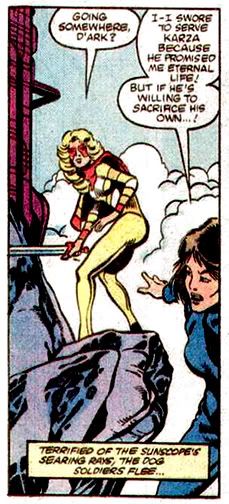 Or, more likely, she just slinks off to some distant corner of the Microverse to lick her wounds and rebuild her sense of self. I wonder what Bill Mantlo's plans for her were, or if he even had any. He did one more issue of Micronauts with no further Captain D'Ark appearances (she doesn't even warrant a trial for war crimes), and then Peter B. Gillis took over for Micronauts: The New Voyages.
Or, more likely, she just slinks off to some distant corner of the Microverse to lick her wounds and rebuild her sense of self. I wonder what Bill Mantlo's plans for her were, or if he even had any. He did one more issue of Micronauts with no further Captain D'Ark appearances (she doesn't even warrant a trial for war crimes), and then Peter B. Gillis took over for Micronauts: The New Voyages.
Captain D'Ark... she combined the hateful and the cute. And lost everything on the ice planet.


